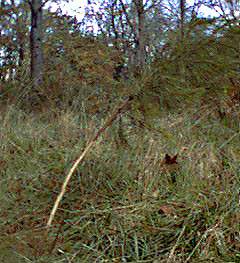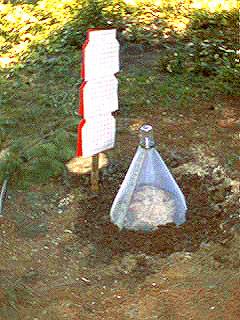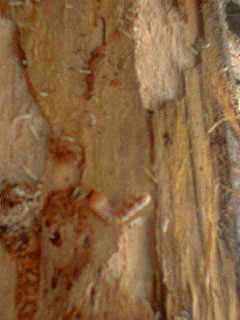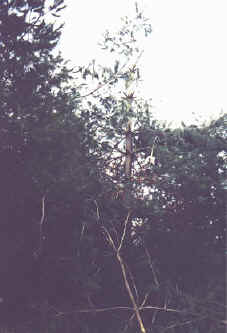"Troubles come
not in single staves, but in batallions." -- William Shakespeare, Macbeth
Insect and Fungal Pathogens

What Bambi's Daddy did!
(deer damage to young loblolly pine)
"Primum non nocere." (First of all, do
no harm) -- A Latin medical proverb.
To make a long story short, pathogens known at the pinetum
will be merely listed, with very little commentary. So far the
pinetum, considering the large number and concentration of
different species of pine trees growing out of their normal
ranges in this one place, has been one lucky pinetum (typed with
crossed fingers).
But there have been some problems:
- pinetip moth
- sawfly larva (mostly Neodiprion lecontii)
- aphids (mostly on P. strobus)
- round-head (cerambycid) borers (? secondary invaders, mostly on crowded P. taeda)
- ips beetle (probable cause of rare P. resinosa drought mortality)
- pine webworm (seems to harm only seedlings)
- bagworm (very tough on all white pines and shore pine and lodgepole pine)
- pine needle scale (finally, almost totally eradicated by a little wasp)
- pine tortoise scale
- needle cast (assume Lophodermium)
- ?tip blight (Diplodia?) [(I hope this is wrong]
- red-band (assume Dothistroma)
- needle rust (Coleosporum)
- armillaria root rot (E. white pine)
- verticicladiella root decline (E. white pine)
- and untold unrecognized others.
No need to advise on therapy for these problems, because
general advice in a specific setting may be very wrong. In
general I have no philosophical bias against the use of chemicals
when used wisely. The problem is that it sometimes turns out in
retrospect that chemical use was probably unwise.
An example is bagworms, which were a problem for six years:
Initially I sprayed extensively with Diazanon which, in
retrospect, may have actually prolonged the bagworm siege by
eliminating parasitic wasps or other natural balancing bagworm
pathogens. B.T. worked one year and then seemed to have no effect
the next year. The last year of this seige I had returned to only
hand picking of bagworms on threatened trees (very time
consuming), rarely augmented by spraying B.T. (which seemed to be
working again) on heavily infested trees. In 1998, the bagworm
problem finally abated and thereafter has been no problem.
The one instance of a seemingly unqualified "Good
Chemical" has been the use of Cleary's 3336F (thiophanate)
for needlecast, both Lophodermium and Dothistroma. This
"saved" almost all of the affected jeffrey and
ponderosa pine in the spring of 1994 and I used it again ('97 and
'98 spring). The timing of spraying depends on the specific
diagnosis (Please see File "#37. 1997 Field Notes" in the Directory). In addition,
for needlecast, progressive bottom-upward pruning and interior
thinning appears to be helping. Every January, the bottom tier of
lateral branches and some of the interior branches are pruned.
Return to Homepage


